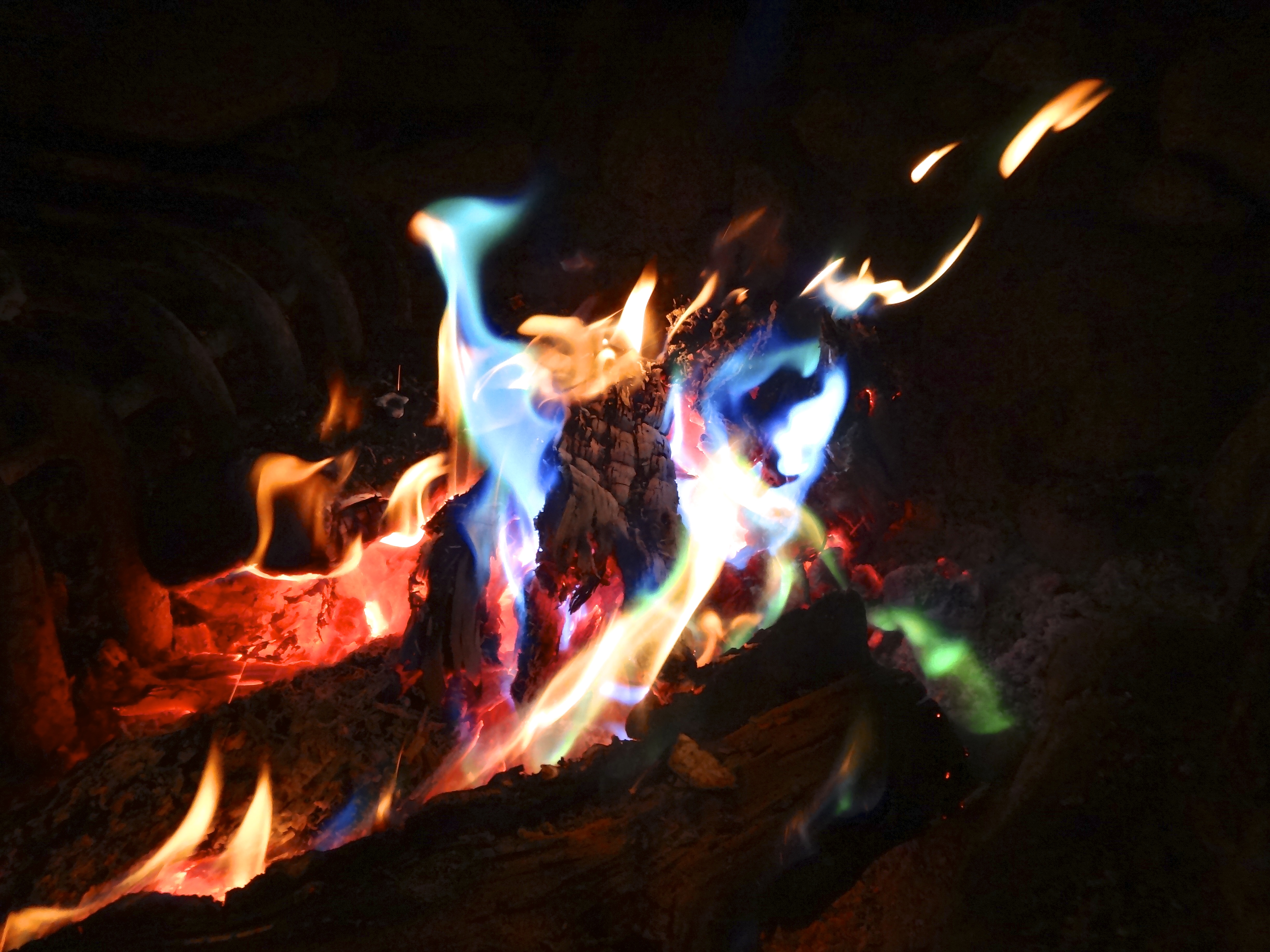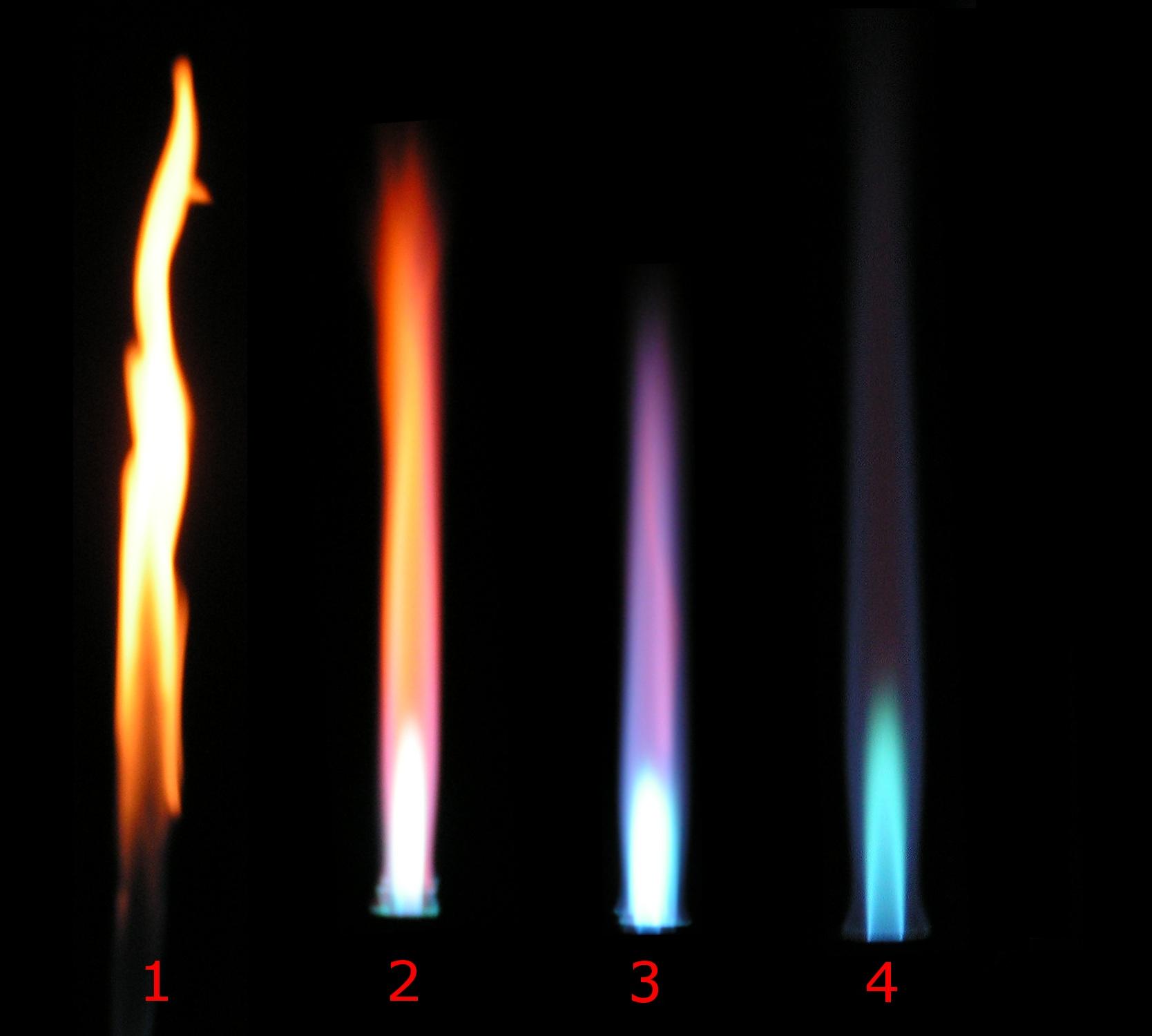colored fire on:
[Wikipedia]
[Google]
[Amazon]

 Colored fire is a common pyrotechnic effect used in stage productions,
Colored fire is a common pyrotechnic effect used in stage productions,

 Colored fire is a common pyrotechnic effect used in stage productions,
Colored fire is a common pyrotechnic effect used in stage productions, fireworks
Fireworks are a class of low explosive pyrotechnic devices used for aesthetic and entertainment purposes. They are most commonly used in fireworks displays (also called a fireworks show or pyrotechnics), combining a large number of devices ...
and by fire performers the world over. Generally, the color of a flame may be red, orange, blue, yellow, or white, and is dominated by blackbody radiation
Black-body radiation is the thermal electromagnetic radiation within, or surrounding, a body in thermodynamic equilibrium with its environment, emitted by a black body (an idealized opaque, non-reflective body). It has a specific, continuous spe ...
from soot and steam. When additional chemicals are added to the fuel burning, their atomic emission
Atomic may refer to:
* Of or relating to the atom, the smallest particle of a chemical element that retains its chemical properties
* Atomic physics, the study of the atom
* Atomic Age, also known as the "Atomic Era"
* Atomic scale, distances com ...
spectra can affect the frequencies of visible light
Light or visible light is electromagnetic radiation that can be perceived by the human eye. Visible light is usually defined as having wavelengths in the range of 400–700 nanometres (nm), corresponding to frequencies of 750–420 te ...
radiation emitted - in other words, the flame appears in a different color dependent upon the chemical additives. Flame coloring is also a good way to demonstrate how fire changes when subjected to heat and how they also change the matter around them.
To color their flames, pyrotechnicians will generally use metal salts. Specific combinations of fuels and co-solvents are required in order to dissolve the necessary chemicals. Color enhancers (usually chlorine donors) are frequently added too, the most common of which is polyvinyl chloride. A practical use of colored fire is the flame test
A flame test is an analytical procedure used in chemistry to detect the presence of certain elements, primarily metal ions, based on each element's characteristic flame emission spectrum (which may be affected by the presence of chloride io ...
, where metal cations are tested by placing the sample in a flame and analyzing the color produced.
Flame colorants
Emitted colors depend on the electronic configuration of the elements involved. Heat energy from the flame excites electrons to a higher quantum level, and the atoms emit characteristic colors (photons with energies corresponding to the visible spectrum) as they return to lower energy levelsCampfire colorants
Flame colorants are becoming popular while camping. Scouts and other outdoor enthusiasts have placed sections ofcopper
Copper is a chemical element with the symbol Cu (from la, cuprum) and atomic number 29. It is a soft, malleable, and ductile metal with very high thermal and electrical conductivity. A freshly exposed surface of pure copper has a pinkis ...
pipe with holes drilled throughout and stuffed with garden hose
A garden hose, hosepipe, or simply hose is a flexible tube used to convey water. There are a number of common attachments available for the end of the hose, such as sprayers and sprinklers (which are used to concentrate water at one point or ...
onto campfire
A campfire is a fire at a campsite that provides light and warmth, and heat for cooking. It can also serve as a beacon, and an insect and predator deterrent. Established campgrounds often provide a stone or steel fire ring for safety. Campfires ...
s to create a variety of flame colors. An easier method of coloring campfires has been fueled by commercial products. These packages of flame colorants are tossed onto a campfire or into a fireplace
A fireplace or hearth is a structure made of brick, stone or metal designed to contain a fire. Fireplaces are used for the relaxing ambiance they create and for heating a room. Modern fireplaces vary in heat efficiency, depending on the design ...
to produce effects.
Although these chemicals are very effective at imparting their color into an already existing flame, these substances are not flammable alone. To produce a powder or solid that, when lit, produces a colored flame, the necessary steps are more complex. To get a powder to burn satisfactorily, both a fuel and oxidizer
An oxidizing agent (also known as an oxidant, oxidizer, electron recipient, or electron acceptor) is a substance in a redox chemical reaction that gains or " accepts"/"receives" an electron from a (called the , , or ). In other words, an oxid ...
will mostly be needed. Common oxidizers include.
* Ammonium perchlorate
* Ammonium nitrate
Ammonium nitrate is a chemical compound with the chemical formula . It is a white crystalline salt consisting of ions of ammonium and nitrate. It is highly soluble in water and hygroscopic as a solid, although it does not form hydrates. It is ...
* Barium chlorate
Barium chlorate, Ba(ClO3)2, is the barium salt of chloric acid. It is a white crystalline solid, and like all soluble barium compounds, irritant and toxic. It is sometimes used in pyrotechnics to produce a green color. It also finds use in the p ...
* Potassium nitrate
Potassium nitrate is a chemical compound with the chemical formula . This alkali metal nitrate salt is also known as Indian saltpetre (large deposits of which were historically mined in India). It is an ionic salt of potassium ions K+ and nitr ...
(saltpeter)
* Potassium chlorate
* Potassium perchlorate
* Strontium nitrate
Strontium nitrate is an inorganic compound composed of the elements strontium, nitrogen and oxygen with the formula Sr( NO3)2. This colorless solid is used as a red colorant and oxidizer in pyrotechnics.
Preparation
Strontium nitrate is typical ...
* Sodium nitrate
Many of these oxidizers also produce a colored flame by themselves. Some of them - as well as the main colorants - are severely toxic
Toxicity is the degree to which a chemical substance or a particular mixture of substances can damage an organism. Toxicity can refer to the effect on a whole organism, such as an animal, bacterium, or plant, as well as the effect on a subs ...
and therefore environmentally damaging.
References
{{reflist Pyrotechnics